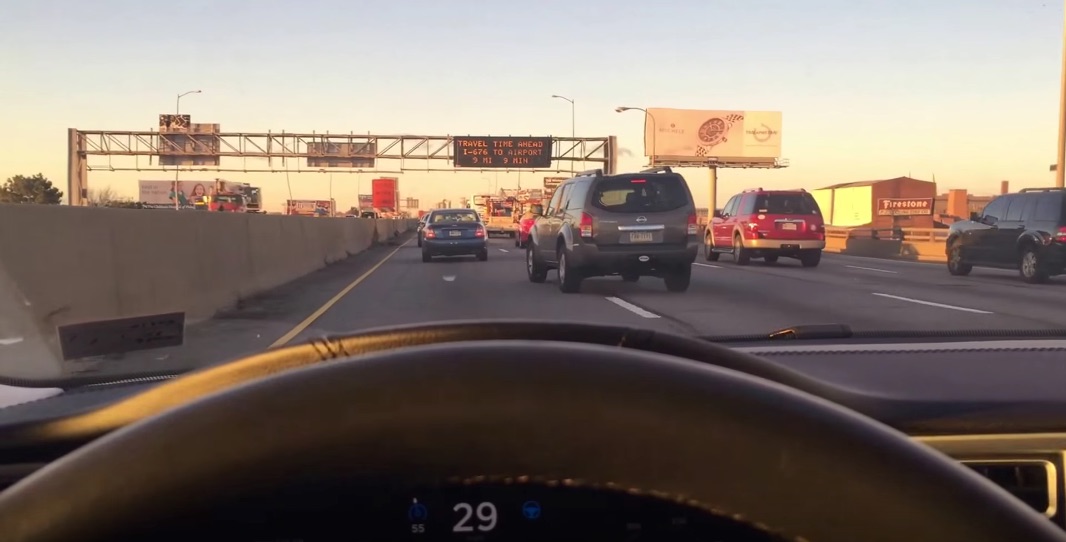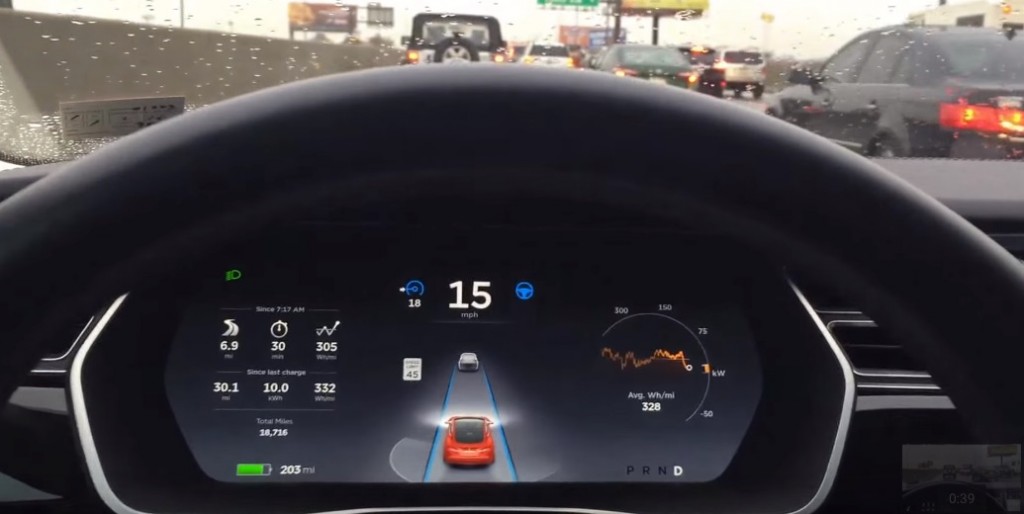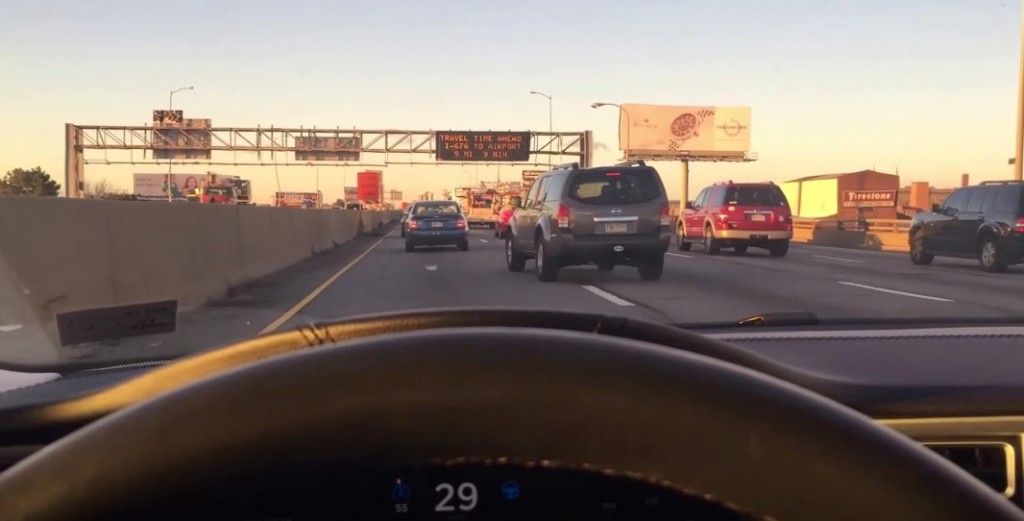Lifestyle
Top 5 Reasons Why I’m Addicted to Tesla Autopilot

As a lucky owner whose Autopilot software update was received at 4:30am on Day 1 of the roll out, I’ve had as much time as anyone to get to know the system and in a nutshell, I can’t see owning a Tesla without it.
Here are the top 5 reasons why I’m addicted to Autopilot:
1. Feedback
This may go without saying, but the Tesla Autopilot System is excellent at giving you feedback to let you know what’s up. I have a basic cruise control feature in my other car and I never use it. I mean never. Given that I use AP nearly every time I’m in the Tesla, I wondered what I hated about my other car’s cruise control, so I attempted to use it recently. I can get over it not being traffic aware and thus only maintaining one speed. What I can’t get over is that I have no idea how to determine when cruise control is engaged. Sure, the word “cruise” shows up when I press a series of confusing buttons to engage but there’s no feedback to tell me when I cancel. I can jam on the brake or take over the accelerator pedal but I have no idea what effect this has on cruise. I pressed the button labeled ‘cancel’ but was still unsure what was going on.
In the Tesla, there is a simple yet clear gray steering wheel symbol to the right of the speedometer that lets you know when the AutoSteer feature is available, and a TACC indicator on the left. A pleasing bright blue is used throughout the displays. In this case, that steering wheel lights blue when AutoSteer is in use. The TACC symbol is simple yet dynamic; showing you what speed it is set to. Blue also plays a role in showing you how the car is controlling itself while engaged in AP driving. Either the road lines light blue to indicate they are being read, or the car ahead of you on the screen lights blue to indicate it is being followed. Blue = on. Gray = available. Got it? Good.
2. It’s Fun
Two words: Pennsylvania Turnpike. Go ahead and insert the most boring and scene-less drive you regularly make. No matter what occasion, time of day, mood or sleep level, driving between Philly and Wilkes-Barre, PA is an instant bore in my mind but Autopilot makes it so much more enjoyable. Call me crazy but open highway driving, despite being responsible for all parts of it, happens automatically for most of us. Staying between painted lines doesn’t require much thought and isn’t at all stimulating. Now you may think that engaging Autopilot would make you even more bored or tired but I’ve found the opposite to be true. You’ve gone from having a monotonous assembly line job to a supervisory one, which activates different thought processes and keeps you interested. Your eyes and mind focus on the lines, the cars around you, and what your own car is doing (or will do) so the drive suddenly becomes a lot less dreadful. Autopilot is no “one trick pony” though, it’s quite good at having the opposite effect on a driver…
3. Relaxation
It wasn’t until I was on the phone with my husband last week while he was driving (hands free of course) that I realized I’m like a slobbering dog when I hear the Autopilot activation chime. He and I were discussing our rather stressful week and when I heard that chime from him activating AP, I was instantly calmed. I firmly believe the Tesla makes all driving better and more relaxing. Despite neck-snapping acceleration, I love driving this car slow and steady. It cradles me safely and luxuriously, and I rarely want my time with it to end. Even so, the ability to enjoy a drive gets tested in any large city’s rush hour traffic. Enter Autopilot, a glorious companion willing to take over some or all of the driving responsibility. Which leads me to…
4. Customization
I’ve written an entire post on this but it bears repeating. You can choose, with very little effort, how much you want the car to do. This is a function of how smart the car is and how quick at processing inputs it is, as well as how easy those inputs are to execute. A little tug of a wheel, tap on the brake or slap of a stalk and you’re changing what you want to do relating to speed, steering, following distance and more. This also includes the ability to use what I’ve heard referred to as “micro corrections.” That is, you can very slightly adjust steering yourself within the lane and without disengaging AutoSteer, which comes in handy when there are concrete barriers or a lack of shoulder in your lane. Plus it gives the system a hint that you’re holding the steering wheel and paying attention.
5. Improvement
This whole entire system came as an update. One day my Tesla had regular cruise control, the next it was traffic aware and thus in my opinion as a former anti-cruise controller, worth using. A few months later, AP as we now know it rolled out and brought us here. Only, there were a ton of tiny improvements in between. Tesla’s fleet learning is revolutionary. We are all more than happy to provide data by using our cars, and Tesla is more than happy to take that knowledge and give it back to us in the form of sometimes imperceptible refinements.
The things I’ve noticed the most are the smoothness of the car’s speed changes and the car’s preference for staying on the highway rather than following a splitting exit lane. Both of these things left much to be desired in early iterations of both TACC and AP but both have gotten infinitely better. It’s sort of a self-fulfilling prophecy. The more you use AP, the more data Tesla gets to make improvements. The more improvements Tesla makes, the more you are willing and wanting to use AP. This is just one of many reasons Tesla’s semi-autonomy is leaps and bound ahead of the competition.
Bonus: Psychedelic Cowbell
For those few Tesla drivers who (begrudgingly so in my case) are considered “millennials,” there is something really magical and even sort of obvious about software updates bringing fun features to the car. After all, we are the generation with smart phones all but surgically implanted in our hands. Forget that though, what I really intend to say is that kids my age grew up playing MarioKart on Nintendo 64 and know the “psychedelic” is really that damned Rainbow Road board that you couldn’t help but fall off of 100 times. Unless you were wimp and chose 50cc engine mode, but friends don’t let friends do such a thing.
For everyone else, it is much more likely you got the “More Cowbell” reference from the Saturday Night Live episode where the phrase was first spoken by Christopher Walken 16 years ago. I doubt many of my fellow 10th grader classmates were watching SNL at that time so I only understood the reference second hand.
All of us can agree though, a company with both the sense of humor and engineering prowess to program and push an Easter egg like this over the air, not 10 days after a random person on Twitter made a joke, is something special. In one single hidden gem like this, there was something for everyone. (And no, the novelty hasn’t worn off yet.)

Lifestyle
Tesla Model S Plaid battles China’s 1500 hp monster Nurburgring monster, with surprising results
There is just something about Tesla’s tuning and refinement that makes raw specs seem not as game-changing.

The Tesla Model S Plaid has been around for some time. Today, it is no longer the world’s quickest four-door electric sedan, nor is it the most powerful. As per a recent video from motoring YouTube channel Carwow, however, it seems like the Model S Plaid is still more than a match for some of its newer and more powerful rivals.
The monster from China
The Xiaomi SU7 Ultra is nothing short of a monster. Just like the Model S Plaid, it features three motors. It also has 1,548 hp and 1,770 Nm of torque. It’s All Wheel Drive and weighs a hefty 2,360 kg. The vehicle, which costs just about the equivalent of £55,000, has been recorded setting an insane 7:04.957 at the Nurburgring, surpassing the previous record held by the Porsche Taycan Turbo GT.
For all intents and purposes, the Model S Plaid looked outgunned in Carwow’s test. The Model S Plaid is no slouch with its three motors that produce 1,020 hp and 1,420 Nm of torque. It’s also a bit lighter at 2,190 kg despite its larger size. However, as the Carwow host pointed out, the Model S Plaid holds a 7:25.231 record in the Nurburgring. Compared to the Xiaomi SU7 Ultra’s record, the Model S Plaid’s lap time is notably slower.
Real-world tests
As could be seen in Carwow’s drag races, however, Tesla’s tech wizardry with the Model S Plaid is still hard to beat. The two vehicles competed in nine races, and the older Model S Plaid actually beat its newer, more powerful counterpart from China several times. At one point in the race, the Xiaomi SU7 Ultra hit its power limit due to its battery’s temperature, but the Model S Plaid was still going strong.
The Model S Plaid was first teased five years ago, in September 2020 during Tesla’s Battery Day. Since then, cars like the Lucid Air Sapphire and the Xiaomi SU7 Ultra have been released, surpassing its specs. But just like the Model Y ended up being the better all-rounder compared to the BYD Sealion 7 and the MG IM6, there is just something about Tesla’s tuning and refinement that makes raw specs seem not as game-changing.
Check out Carwow’s Model S Plaid vs Xiaomi SU7 drag race video below.
Lifestyle
500-mile test proves why Tesla Model Y still humiliates rivals in Europe
On paper, the BYD Sealion 7 and MG IM6 promised standout capabilities against the Model Y.

BYD is seeing a lot of momentum in Europe, so much so that mainstream media has taken every opportunity to argue that the Chinese automaker has beaten Tesla in the region. But while BYD sales this year in Europe are rising and Tesla’s registrations remain challenged, the raw capabilities of vehicles like the Model Y are difficult to deny.
This was highlighted in a 500-mile challenge by What Car? magazine, which showed that the new Tesla Model Y is more efficient, cheaper to run, and more reliable than rivals like the BYD Sealion 7, and even the nearly 400 KW-charging MG IM6.
Range and charging promises
On paper, the BYD Sealion 7 and MG IM6 promised standout capabilities against the Model Y. The Sealion 7 had more estimated range and the IM6 promised significantly faster charging. When faced with real-world conditions, however, it was still the Model Y that proved superior.
During the 500-mile test, the BYD nearly failed to reach a charging stop, arriving with less range than its display projected, as noted in a CarUp report. MG fared better, but its charging speeds never reached its promised nearly-400 kW charging speed. Tesla’s Model Y, by comparison, managed energy calculations precisely and arrived at each stop without issue.
Tesla leads in areas that matter
Charging times from 25% to 80% showed that the MG was the fastest at 17 minutes, while Tesla and BYD were close at 28 and 29 minutes, respectively. Overall efficiency and cost told a different story, however. The Model Y consumed 19.4 kWh per 100 km, compared to 22.2 for MG and 23.9 for BYD. Over the full trip, Tesla’s charging costs totaled just £82 thanks to its supercharger network, far below BYD’s £130 and MG’s £119.
What Car? Magazine’s testers concluded that despite BYD’s rapid sales growth and the MG IM6’s seriously impressive charging speeds, Tesla remains the more compelling real-world choice. The Model Y just offers stability, efficiency, and a proven charging infrastructure through its Supercharging network. And as per the magazine’s hosts, the Model Y is even the cheapest car to own among the three that were tested.
Watch What Car? Magazine’s 500-mile test in the video below.
Lifestyle
Tesla Cybertruck slapped with world’s least intimidating ticket, and it’s pure cringe
One cannot help but cringe and feel second-hand embarrassment at the idea of a person just driving around with a stack of these babies.

A Cybertruck parked at Stanford Shopping Center in California was recently hit with what might be the most try-hard piece of paper ever slipped under a wiper blade: a “fake citation” accusing the driver of supporting a “fascist car.”
The note, shared on X by Tesla staff program manager Ryan Torres, quickly made the rounds on X, where it quickly gained attention as an example of how not to protest.
The world’s least intimidating ticket
According to the citation, the supposed “violation” was “driving a fascist car.” The remedial action? Take the bus, call an Uber, or ride a bike. The note also dubbed Elon Musk a “chainsaw-wielding Nazi billionaire.” Now, protests against Tesla and Elon Musk have become commonplace this year, but one cannot help but cringe and feel second-hand embarrassment at the idea of a person just driving around with a stack of fake anti-Tesla/Musk citations.
Torres pointed out the irony himself in his post on X. Tesla currently employs over 140,000 Americans, and SpaceX has put the U.S. firmly back at the top of space technology. As Torres put it, maybe the person behind the world’s least intimidating ticket should “read a book on innovation before vandalizing” other people’s property.
Peak performative clownery
Not to mention that the fake ticket’s logic collapses under its own weight. EVs like the Cybertruck are literally designed to reduce emissions, not “destroy the economy.” If anything, Tesla has bolstered the United States’ economy by fueling jobs in engineering, manufacturing, and clean energy. It’s not the first time a Tesla has been the target of vandalism or politically charged notes, but this one stands out for sheer cringe value.
Torres summed it up neatly: “Peak clownery.” On that point, at least, the citation earns full marks. In a way, though, perhaps cringe fake tickets are not as bad as the literal firebombs that were being thrown at Tesla stores and cars earlier this year because some critics were gleefully misinformed about Elon Musk.
![Tesla Autopilot Version 7.0 Dashboard Display [Source: Tesla Motors]](http://www.teslarati.com/wp-content/uploads/2015/10/Tesla-Version-7-Autopilot-Dash-1024x384.jpg)










